The Axis Powers
World War II was fought between two major groups of nations. They became known as the Axis and Allied Powers. The major Axis Powers were Germany, Italy, and Japan. The alliance began to form in 1936. On October 15, 1936, Germany and Italy signed a friendship treaty that formed the Rome-German Axis. It was after this treaty that Italian dictator, Benito Mussolini, used the term “Axis” to refer to their alliance. Shortly after this, on November 25, 1936, Japan and Germany both signed the Anti-Comintern Pact, which was a treaty against communism. An even stronger alliance was signed between Germany and Italy on May 22, 1939, called “The Pact of Steel”. This treaty would later be called “The Tripartite Pact” when Japan signed it on September 27, 1940. The three main Axis Powers were allies in the war.
Leaders of the Axis Powers
The three main member countries of the Axis Powers were ruled by dictators. They were:
- Germany: Adolf Hitler – Hitler became Chancellor of Germany in 1933 and Fuhrer in 1934. He was a ruthless dictator who hated Jewish people. He wanted to purge Germany of all weak people. He also wanted to take control of Europe.
- Italy: Benito Mussolini – Mussolini was supreme dictator of Italy. He founded the concept of a fascist government where there is one leader and one party that has total power. He was an inspiration to Adolf Hitler.
- Japan: Emperor Hirohito – Hirohito reigned as Emperor of Japan from 1926 until 1989. He remained Emperor after the war. The first time his subjects heard his voice was when he announced Japan’s surrender on the radio.
Other countries in the Axis Alliance:
- Hungary – Hungary became the fourth member of the Tripartite Pact. Hungary played a large role in the invasion of Russia.
- Bulgaria – Bulgaria started out on the Axis side of the war, but after being invaded by Russia ended up on the side of the Allies.
- Romania – Similar to Bulgaria, Romania was on the side of the Axis Powers and helped to invade Russia. However, by the end of the war it changed sides and fought for the Allies.
- Finland – Finland never signed the Tripartite Pact, but fought with the Axis countries against Russia.
Leaders in WWII – The Axis Powers
ADOLF HITLER
- Occupation: Dictator of Germany
- Born: April 20, 1889 in Braunau am Inn, Austria-Hungary
- Died: April 30 1945 in Berlin, Germany.
Best known for: Starting World War II and the Holocaust Adolf Hitler was the leader of Germany from 1933 to 1945. He was Chancellor of the Nazi party and became a powerful dictator. Hitler started World War II by invading Poland and then invading many other European countries. He is also known
- for wanting to exterminate the Jewish people in the Holocaust.

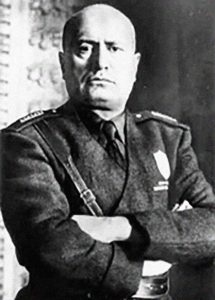
BENITO MUSSOLINI
- Occupation: Dictator of Italy
- Born: July 29, 1883 in Predappio, Italy
- Died: April 28, 1945 in Giulino di Mezzegra, Italy
Best known for: Ruling Italy during World War II and founding the Fascist Party
Founder of the Fascist Party in 1919. In 1922, Mussolini and 30,000 members of the party marched to Rome and took control of the government. By 1925, Mussolini had total control of the government and was established as dictator. He became known as “Il Duce”, which means “the leader.” In 1935, Italy invaded and conquered Ethiopia. He also allied himself with Adolf Hitler and Nazi Germany in an alliance called the “Pact of Steel.”
EMPEROR HIROHITO
- Occupation: Emperor of Japan
- Born: April 29, 1901 in Tokyo, Japan
- Died: January 7, 1989 in Tokyo, Japan
- Reign: December 25, 1926 to January 7, 1989
Best known for: Leader of Japan during World War II and Japan’s longest-reigning monarch.
Hirohito was born on April 29, 1901 in the royal palace in Tokyo, Japan he was also known as Prince Michi. In 1921, Hirohito took over the leadership of Japan. He was called the Regent of Japan. He would rule as regent until his father died in 1926. Then Hirohito became the emperor. In 1940, Japan allied with Nazi Germany and Italy forming the Tripartite Pact. In order to allow Japan to continue to expand in the South Pacific, Japan bombed the United States Navy at Pearl Harbor. This allowed Japan to take over much of the South Pacific including the Philippines .
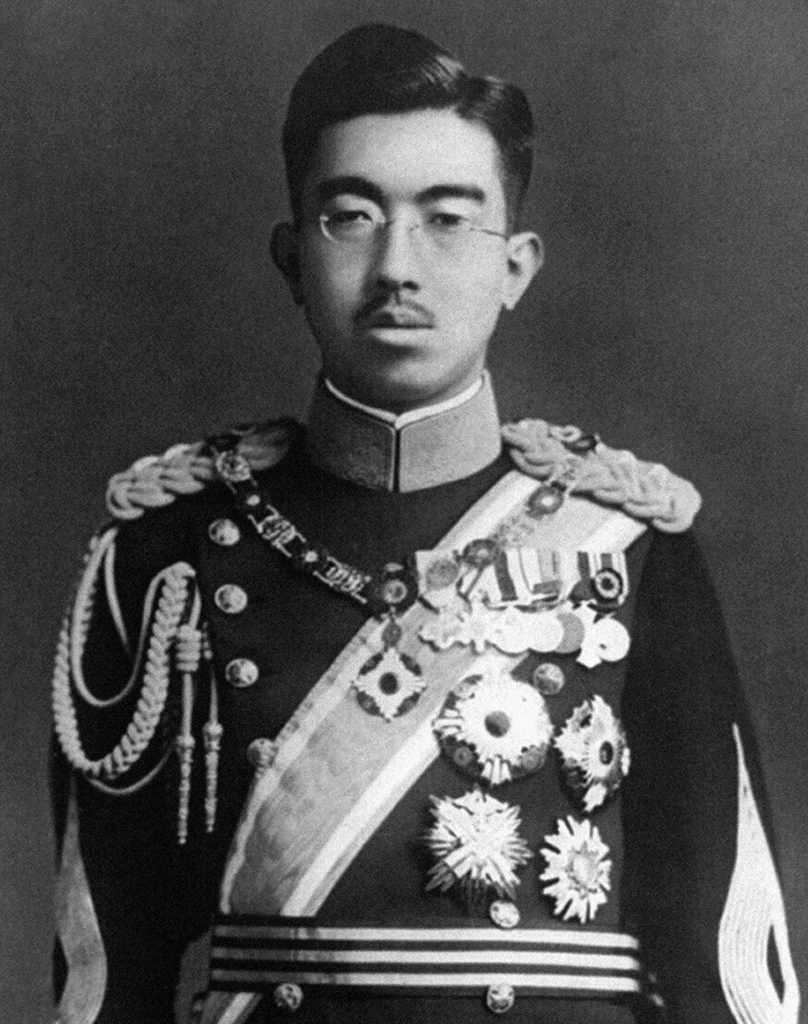
The Allied Powers
The major Allied Powers were Britain, France, Russia, and the United States. The Allies formed mostly as a defense against the attacks of the Axis Powers. The original members of the Allies included Great Britain, France and Poland. When Germany invaded Poland, Great Britain and France declared war on Germany.
Russia becomes an Ally
At the start of World War II, Russia and Germany were friends. However, on 22 June 1941 Hitler, the leader of Germany, ordered a surprise attack on Russia. Russia then became an enemy of the Axis Powers and joined the Allies.
The US joined the Allied Powers
The United States had hoped to remain neutral during World War II. However, the US was attacked by surprise at Pearl Harbor by the Japanese. This attack united the country against the Axis Powers and turned the tide of World War II in the favour of the Allies.
Leaders of the Allied Powers:
- Great Britain: Winston Churchill – Prime Minister of Great Britain during most of World War II, Winston Churchill was a great leader. His country was the last country fighting against the Germans in Europe. He is known for his famous speeches to his people when the Germans were bombing them during the Battle of Britain.
- United States: Franklin D. Roosevelt – One of the greatest presidents in the history of the United States, President Roosevelt led the country out of the Great Depression and through World War II.
- Harry S. Truman – Truman became president after Roosevelt died. He had to make the call to use the atomic bomb against Japan.
- Russia: Joseph Stalin – Stalin’s title was General Secretary of the Communist Party. He led Russia through terrible and devastating battles with Germany. Millions and millions of people died. After winning the war, he set up the Eastern Bloc of Soviet led communist states.
- France: Charles de Gaulle – Leader of the Free French,
de Gaulle led the French resistance movement against
Germany
Operation
Leaders in WWII – The Allied Powers
WINSTON CHURCHILL
- Born: November 30th, 1874 in Oxfordshire, England
- Occupation: Prime Minister of Great Britain
- Died: 24 January 1965 in London, England
Winston Churchill was one of the great world leaders of the 20th century. His leadership helped Britain to stand strong against Hitler and the Germans, even when they were the last country left fighting. Winston Churchill as prime minister (1940–45, 1951–55) rallied the British people during World War II and led his country from the brink of defeat to victory.
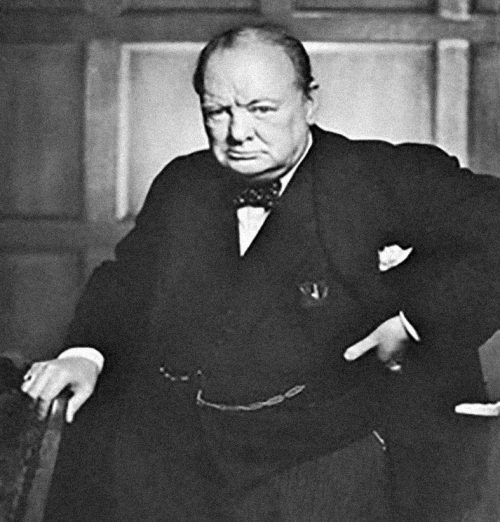

CHARLES DE GAULLE
- Occupation: General and President of France
- Born: November 22, 1890 in Lille, France
- Died: November 9, 1970 in Colombey-les-Deux-Eglises, France
- Best known for: Leading Free France during World
War II
Charles de Gaulle led the Free French forces in resisting capitulation to Germany during World War II and became provisional president of France in the immediate aftermath of the war. Later he was an architect of the Fifth Republic and was president from 1958 to 1969.
FRANKLIN D. ROOSEVELT
- Born: January 30, 1882 Hyde Park, New York, U.S
- Occupation: 32nd President of the United States
- Died: April 12, 1945 (aged 63) Warm Springs, Georgia, U.S
Franklin D. Roosevelt led the United States from isolationism to victory over Nazi Germany and its allies in World War II. The devastating surprise attack at Pearl Harbor on December 7, 1941, which former President Franklin D. Roosevelt called “the date which will live in infamy.” It was this event that officially drew the United States into the Second World War. He spearheaded the successful wartime alliance between Britain, the Soviet Union and the United States and helped lay the groundwork for the post-war peace organization that would become the United Nations.
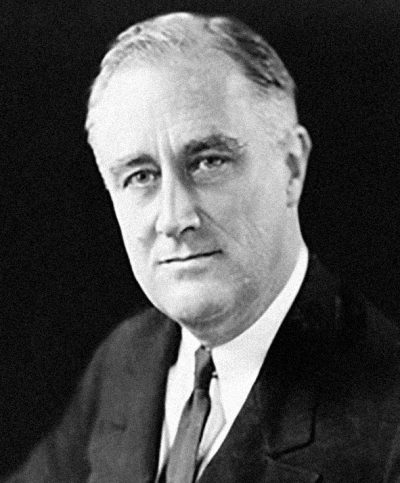
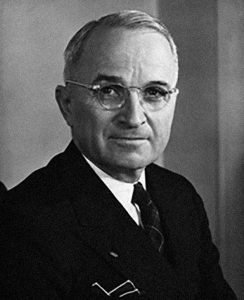
HARRY S. TRUMAN
- Born: May 8, 1884 Lamar, Missouri
- Occupation: 33rd President of the United States
- Died : December 26, 1972 (aged 88) Kansas
City, Missouri
Harry S. Truman (1884-1972), the 33rd U.S. president, assumed office following the death of President Franklin Roosevelt (1882-1945). In the White House from 1945 to 1953, Truman made the decision to use the atomic bomb against Japan, helped rebuild postwar Europe, worked to contain communism
JOSEPH STALIN
- Occupation: General Secretary of the Communist Party of the Soviet Union (1922–1952) and Chairman of the Council of Ministers of the Soviet Union (1941–1953)
- Died: 5 March 1953 (aged 74)
As war leader, Stalin maintained close personal control over the Soviet battlefronts, military reserves, and war economy. In 1939, on the eve of World War II, Joseph Stalin and German dictator Adolf Hitler (1889-1945) signed the German-Soviet Nonaggression Pact. In June 1941, Germany broke the Nazi-Soviet pact and invaded the USSR. As German troops approached the Soviet capital of Moscow, Stalin remained there and directed a scorched earth defensive policy, destroying any supplies or infrastructure that might benefit the enemy. During the Battle of Stalingrad from August 1942 to February 1943, the Red Army defeated the Germans and eventually drove them from Russia

Italian Campaign
When the Allies won the North African Campaign on May 13, 1943, a quarter-million German and Italian troops surrendered at Tunisia, on the north coast of Africa. With the huge Allied army and navy in the southern Mediterranean now freed for further action, British and American strategists faced two options: Transfer these forces north for the impending invasion of Europe from the English Channel, or remain in theater to strike at southern Italy.
The Allies, after some dissension, decided to press north into Italy. The stepping stone to its mainland would be the island of Sicily.
The invasion of Sicily, code-named Operation Husky, began before dawn on July 10, 1943, with combined air and sea landings involving 150,000 troops, 3,000 ships and 4,000 aircraft, all directed at the southern shores of the island. This massive assault was nearly cancelled the previous day when a summer storm arose and caused serious difficulties for paratroopers dropping behind enemy lines that night. However, the storm also worked to the Allies’ advantage when Axis defenders along the Sicilian coast judged that no commander would attempt amphibious landings in such wind and rain. By the afternoon of July 10, supported by shattering naval and aerial bombardments of enemy positions, 150,000 Allied troops reached the Sicilian shores, bringing along 600 tanks..
The overall commander was American General Dwight D. Eisenhower, as Commander in Chief (C-in-C) of all the Allied forces in North Africa. The Allied land forces were from the American, British and Canadian armies, and were structured as two task forces.
The Eastern Task Force (also known as Task Force 545)was led by General Sir Bernard Montgomery and consisted of the British Eighth Army.The Western Task Force (Task Force 343) was commanded by Lieutenant General George S. Patton and consisted of the American Seventh Army. The two task force commanders reported to Alexander as commander of the 15th Army Group.
Allied troops encountered light resistance to their combined operations. Hitler had been so deceived by “Mincemeat” that he had left only two German divisions in Sicily to battle Allied soldiers.For the next five weeks, Patton’s army moved toward the northwestern shore of Sicily, then east toward Messina.
On July 24, 1943, Prime Minister Benito Mussolini was deposed and arrested. A new provisional government was set up under Marshal Pietro Badoglio who had opposed Italy’s alliance with Nazi Germany and who immediately began secret discussions with the Allies about an armistice. On July 25, the day after Mussolini’s arrest, the first Italian troops began withdrawing from Sicily. As Patton and Montgomery closed in on the northeastern port of Messina, the German and Italian armies managed (over several nights) to evacuate 100,000 men, along with vehicles, supplies and ammunition, across the Strait of Messina to the Italian mainland.
The battle for Sicily was complete. The advance against the Italian mainland in September would take more time and cost the Allies more troops than they anticipated.

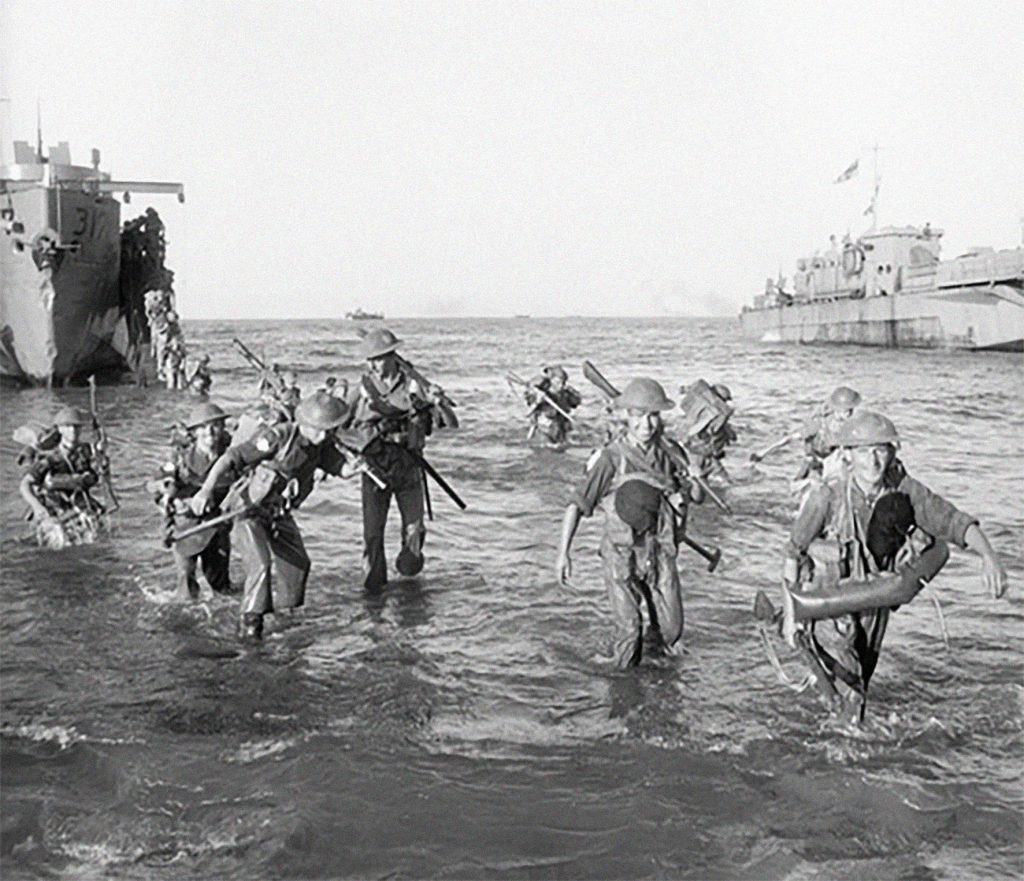

Invasion of Italy
On 3 September 1943, the 8th Army crossed Messina and invaded the ‘toe’ of Italy. The Germans retreated slowly using demolitions, mines and booby-traps to delay the British. Early on 9 September, General Mark Clark’s US 5th Army began landing on the beaches south of Salerno, where they met stiff resistance. At the same time, the British 1st Airborne Division went ashore at Taranto on the ‘heel’ of Italy. By the end of September, the Allies were in Naples.
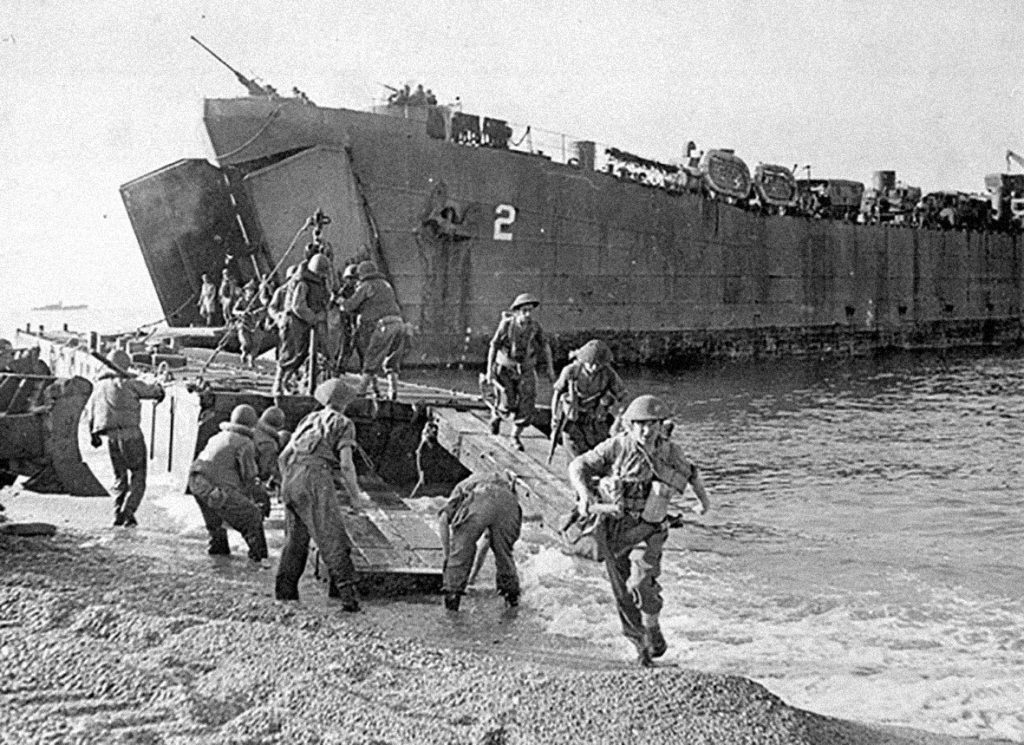
Shortly before the Salerno and Taranto landings, Italian dictator Benito Mussolini was overthrown. The new Italian government surrendered to the Allies.
Most of the Italian Army was quickly disarmed by the Germans, whose troops now manned key positions throughout Italy. Once the Allies had landed, the Germans originally plannedto withdraw slowly to northern Italy.
Hitler ordered his forces to hold a defensive position south of Rome This focused on the Gustav Line, which ran from coast to coast and included the heights and monastery of Monte Cassino.
As the Allies inched towards the Gustav Line, they encountered other German defence positions, anchored on the natural strength of rivers or mountains, each of which had to be captured before the advance could continue. These included the Volturno Line and the Barbara Line, both of which were broken in October and November 1943.
In May 1944, a general Allied offensive breached the Gustav Line at several points and troops entered the Liri Valley. During this attack, 8th Army troops finally occupied Monte Cassino. On 4 June, the 5th Army entered Rome. British forces then attacked in the east. This was followed five days later by an American assault in the west. Cutting through enemy resistance, the attacks converged on Bologna, which fell on 21 April. Four days later, the Allies crossed the River Po, and Verona was captured on 26 April.
Mussolini, who had earlier been rescued from Italian captivity by German commandos, retreated north with the Germans and their ISR allies. But he was captured by partisans and executed on 28 April 1945. The following day, the Germans in Italy surrendered to the Allies.
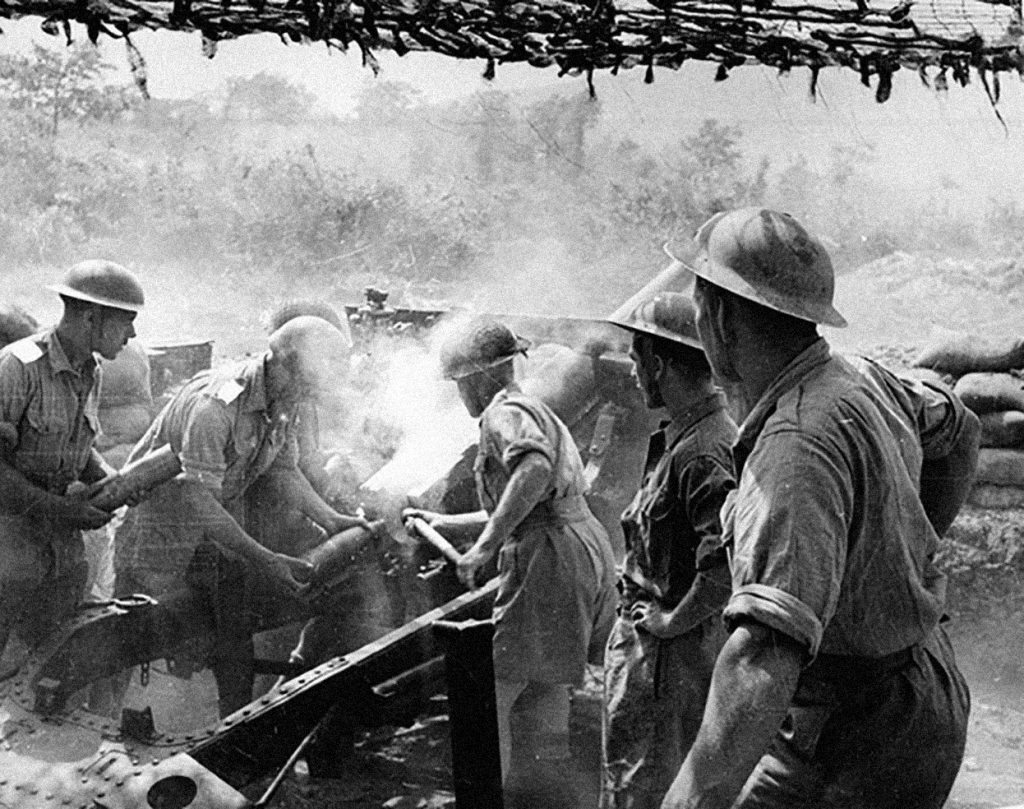
Operation Mincemeat
In April 1943, a month before the Allied victory in North Africa, German agents recovered the body of a British Royal Marine pilot from the waters off a Spanish beach. Documents in an attaché case handcuffed to the officer’s wrist provided a goldmine of intelligence about the Allies’ secret plans, and German agents quickly sent the documents up the chain of command where they soon reached German leader Adolf Hitler (1889-1945). Hitler studied the captured plans carefully, and, taking full advantage of their top-secret details, directed his troops and ships to reinforce the islands of Sardinia and Corsica, west of Italy, against an impending Allied invasion. There was only one problem: The recovered body–which was not a Royal Marine but actually a homeless man from Wales who had committed suicide–and its documents, were an elaborate British diversion called Operation Mincemeat. By the time Hitler redirected his troops in the summer of 1943, a massive Allied invasion force was sailing to Sicily.